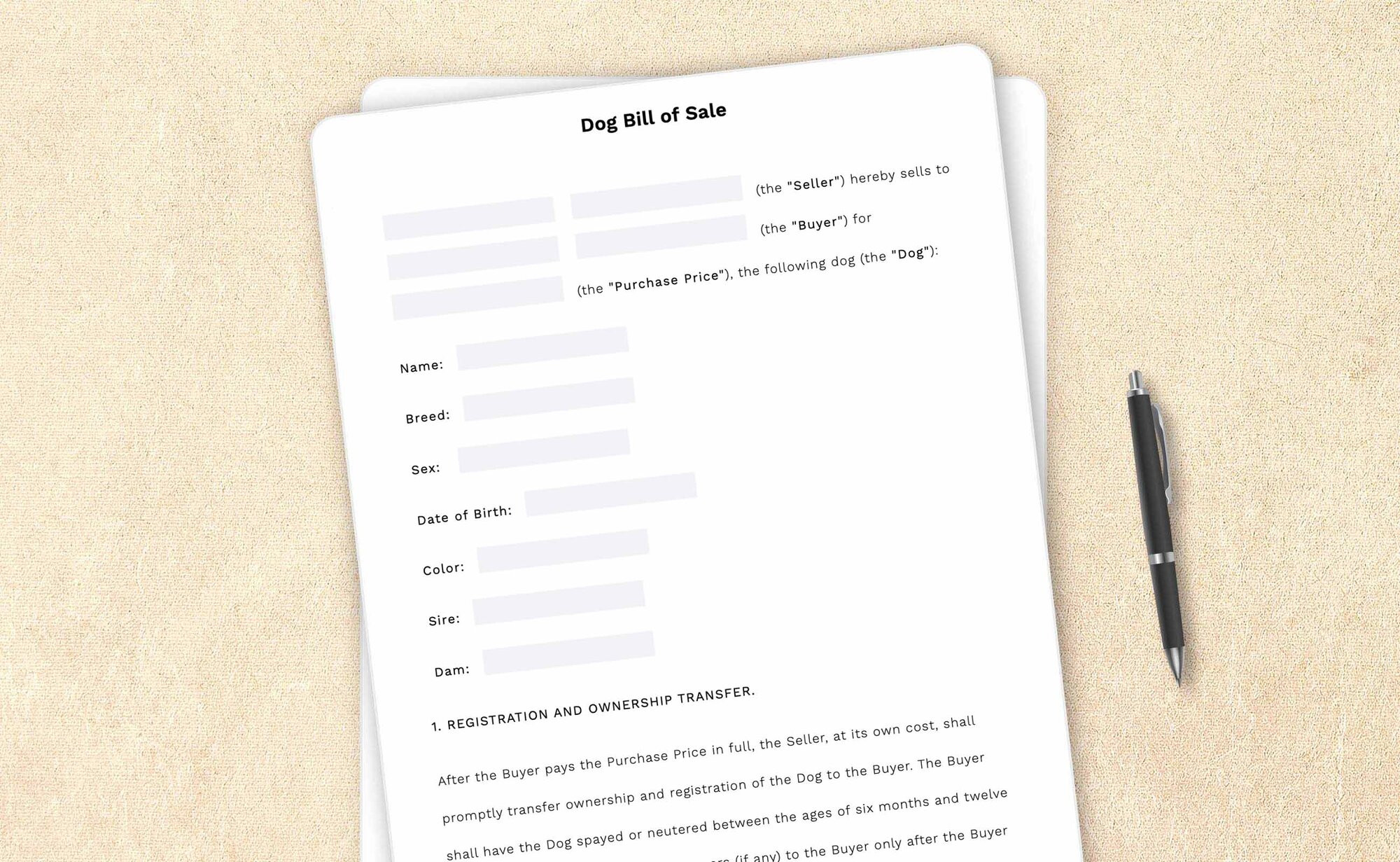- Name:
- Breed:
- Sex:
- Date of Birth:
- Color:
- Sire:
- Dam:
1. REGISTRATION AND OWNERSHIP TRANSFER.
After the Buyer pays the Purchase Price in full, the Seller, at its own cost, shall promptly transfer ownership and registration of the Dog to the Buyer. The Buyer shall have the Dog spayed or neutered between the ages of six months and twelve months. The Seller shall mail AKC papers (if any) to the Buyer only after the Buyer provides the Seller with a copy of the spay or neuter certificate, or other statement from a certified veterinarian (on his or her official letterhead) that the Dog has been surgically altered. The Seller shall provide the Buyer with the registration paperwork within
2. MEDICAL CONDITIONS AND MEDICATIONS.
The Buyer has been advised of the following medical conditions and medications that the Dog is taking:
3. SELLER'S WARRANTIES.
The Seller warrants to Buyer that it is the legal and true owner of the Dog and has the unqualified right to sell the Dog. The Seller further warrants that the Dog is sold free and clear of any liens, security interests, mortgages, or other encumbrances.
4. SHORT-TERM GOOD HEALTH WARRANTY.
The Seller guarantees the health of the Dog on pick-up or on shipment for a period of
5.
The Dog is warranted against fatal genetic defects for a period of
6. LIMITATIONS ON TRANSFER.
Under no circumstances may the Buyer sell, lease, or give the Dog to any pet shop, research laboratory, or similar facility (including dog pounds or rescues). If the Buyer can no longer provide a home for the Dog, the Buyer shall notify the Seller before making any transfer and the Seller shall help find a new home for the Dog or reclaim the Dog at the Buyer's expense. If the Dog is returned under this section, the Buyer shall help with any legal action necessary to transfer ownership and registration of the Dog to its new owner.
7. NO REPRESENTATIONS OF FUTURE ABILITIES.
The Seller has made no representations, verbal or implied, about the Dog's future abilities.
[SIGNATURE PAGE FOLLOWS]
Each party is signing this bill of sale on the date stated opposite that party's signature.
| Date:_________________ | By:__________________________________________ Name: Phone No.: |
| Date:_________________ | By:__________________________________________ Name: Phone No.: |
How-to guides, articles, and any other content appearing on this page are for informational purposes only, do not constitute legal advice, and are no substitute for the advice of an attorney.
Dog bill of sale: How-to guide
Bringing a pet into a family is both an emotional and practical decision. Once the decision has been made, the family may already be attached to the animal, looking forward to the years they have in front of them with their pet.
Bills of sale are important documents and evidence of a dog being purchased or sold. They provide records of the transfer and protect the rights of all parties to the transaction. Although complete assurances of fitness are impossible for any living creature, a comprehensive dog bill of sale will solidify the parties’ understanding of what illnesses or imperfections should be expected or accepted.
Important considerations while drafting a dog bill of sale form

1. Know your rights when buying a dog or puppy from a seller
While purchasing a dog or a puppy from a pet store, know the rights well before signing the adoption contract for the legal transfer of the pet. Most states have special laws—similar to “lemon laws” regulating the sale of cars—governing pet sales made by such stores. For example, the current dog owner may be required to provide the background information on the dog/puppy, including its health and vaccination history, and may be obliged to exchange a sick dog for a healthy one (as stated in the drafted dog/puppy bill of sale).
2. Ensure accurate contact information
Getting the other party's correct name and physical address to this legal agreement is essential. Contact that person or company immediately if a question emerges about ownership or the dog’s fitness.
3. Inspect the living conditions before buying a dog
If you're the potential buyer, look around the facility and environment where the dog has lived. Ensure those areas are clean and the dog receives sufficient food and water. This simple initial tour may tell you more about the seller than any papers or promises.
4. Examine the dog before making a purchase
A visual inspection of the dog can also go a long way toward making an intelligent purchase. Ensure that the dogs or puppies are alert and energetic and that their eyes and noses are clear.
5. Include additional requirements for pure-breed dog transactions
When buying or selling a pure-breed dog, consider inserting additional requirements into the document (e.g., confirmation that the dog has been identified with a tattoo or microchip).
Important components of a dog or puppy bill of sale form

The following information will help potential buyers understand the terms of a dog's bill of sale. Please review the entire document before starting the step-by-step process.
1. Purchase price
Write the purchase price of the animal. Ensure to include the total cost, including any previous down payments made to the dog.
2. Names of parties
This section identifies the parties and the date of the agreement. One party to this bill is called the “Seller,” who can be the current owner of the dog, pet store owner, or breeder. The other is called the “Buyer,” who'll be the new dog owner.
3. Description of the dog
In this part of the dog bill of sale, provide all the dog-specific information, including name, breed, sex, color, dog’s sire and dam, and registration number (if provided). Be detailed as possible, ensuring the dog can be identified clearly from the description.
4. Transfer of ownership
In this paragraph, the seller confirms to fulfill all the requirements of the dog's ownership transfer to the new owner. This may involve changing the American Kennel Club and state or county-level associations. The seller must provide copies of any transfer papers or required forms in the selling process.
5. Short-term good health warranty
This is a promise that the dog will be free from immediate illnesses after the sale date. The buyer can examine the dog and determine if there are health problems from the start of the ownership period. If such issues are confirmed through a veterinary examination, the buyer can return the dog to the previous owner and get a comparable one. Insert the period during which the buyer has this right. Ordinarily, this is between 48 and 72 hours.
6. Month of good health warranty
Although the buyer is already protected, if the dog is found to be ill immediately, this clause permits the buyer to investigate the dog’s health thoroughly. If the dog has more latent, long-term defects, as confirmed by a veterinarian’s examination, the buyer can exchange the dog for a comparable one. Insert the period during which the buyer has this right. Ordinarily, this is about six months, although the parties can agree to more or less time at their discretion.
Also, include whether this warranty won't cover certain environmental ailments.
7. Spaying and neutering
This section clarifies that the buyer will spay or neuter the dog and conditions their receipt of AKC papers (if any) on that promise. If there are no AKC papers, the buyer remains obligated to complete those procedures.
8. Limitations on transfer
It gives the seller the right to reclaim or find an alternate home for the dog if the buyer intends to give it away.
9. No representations of future abilities
The buyer’s acknowledgment that there have been no promises that the dog will be able to do particular acts in the future.
10. Additional provisions
This optional provision allows the buyer and seller to include any representations, warranties, or other provisions particular to their situation. For example, the seller may require the buyer to take the dog in for “X” number of veterinary visits in a given year or ensure heartworm-preventative measures are taken.
11. Signatures
Both parties should sign this dog bill of sale form and provide contact information on the document. The parties may decide that they want third-party witnesses or a public notary to view the dog bill of sale signing, although this isn't required in many states. However, this precaution could protect the parties from later claims of invalidity or lack of agency.
Use a dog bill of sale template
A dog bill of sale includes important information about the dog, such as name, sex, color, and registration number. It also contains details about the seller and buyer, payment details, and any other conditions of the sale. The template can also document a home visit, which is vital to ensure the dog is placed in a suitable environment.
However, deciding whether a self-made dog bill of sale has included all the important details can take time and effort. This is where a template can be helpful as a starting point.
LegalZoom offers a user-friendly and professionally vetted dog bill of sale template for an affordable price.
Enter your responses in the questionnaire’s fillable fields, complete the document, and download it in a .pdf file. You also get access to LegalZoom’s rich editor to customize your documents according to your individual requirements. LegalZoom also offers other bill of sale templates that can be used for other property transfers.
Frequently asked questions
What's a dog/puppy bill of sale?
You've decided to add a furry friend as a new family member. There doesn't have to be anything ruff about buying or selling dogs and puppies.
A dog/puppy bill of sale is a legally binding document that makes the new puppy official and outlines what's expected of everyone involved. Generally, a dog/puppy bill of sale is a receipt and proof that a seller agrees to sell and transfer ownership of their dog or puppy to a buyer.
What essential information is required to draft a dog or puppy bill of sale form?
A dog/puppy bill of sale is an adoption contract for a dog or puppy. Here's the information needed to fill in and complete a dog bill of sale:
- Who's selling the dog: Have their name and contact information ready
- Who's buying the dog: Have their name and contact information ready
- Details about the furry friend: Know the pup's name, color, birthday, gender, and breed
